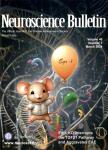Therapeutic Potential of Glucagon-Like Peptide-1 Cleavage Product for Alzheimer’s Disease
Therapeutic Potential of Glucagon-Like Peptide-1 Cleavage Product for Alzheimer’s Disease作者机构:Department of Internal Medicine Gerontology and Geriatric Medicine Wake Forest School of Medicine Winston-Salem NC 27157 USA Department of Physiology and Pharmacology Wake Forest School of Medicine Winston-Salem NC 27157 USA Department of Neurobiology and Anatomy Wake Forest School of Medicine Winston-Salem NC 27157 USA
出 版 物:《Neuroscience Bulletin》 (神经科学通报(英文版))
年 卷 期:2019年第35卷第5期
页 面:934-936页
核心收录:
学科分类:0710[理学-生物学] 1002[医学-临床医学] 1001[医学-基础医学(可授医学、理学学位)] 100203[医学-老年医学] 10[医学]
基 金:supported by the National Institutes of Health, USA (K99/R00 AG044469, R01 AG055581, and R01 AG056622) the Bright Focus Foundation (A2017457S)
主 题:Alzheimer GLP-1 its AD has can is
摘 要:Alzheimer’s disease (AD) is a devastating neurodegenerative disease and the most common form of dementia in the elderly. Concurrent with an aging population, the incidence of AD has been rising steadily and become a global threat to public health [1]. Unfortunately, there are currently no effective interventions that can cure AD or slow its progression, and recently finished clinical trials targeting brain amyloid-b (Ab) accumulation have not succeeded in improving cognitive impairments in AD patients [1]. Thus, it is necessary and urgent to identify alternative diseasemodifying strategies to alleviate AD pathophysiology. In this perspective article, we focus on glucagon-like peptide- 1 (GLP-1), specifically its natural cleavage product GLP-1 (9-36), as a potential therapeutic approach for AD.



